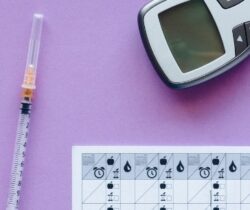Diabetes (or diabetes mellitus, to give it its formal title) is a medical condition where there is too much glucose (sugar) in the blood. Over time, this damages blood vessels and nerves, resulting in serious, long-term health complications.
Diabetes generally affects men and women in similar ways, however, there are some differences. For example, diabetes and high blood glucose levels can impact male sexual and reproductive health.
In this article, we’ll describe and explain the effects of diabetes on men. We’ll also discuss ways of preventing or minimising them.
Type 1 vs. type 2 diabetes
Diabetes affects how the body converts food into energy. When you eat, your body breaks the food down into glucose, which is then released into your bloodstream. As your blood glucose levels rise, your pancreas releases insulin to help the glucose to enter your cells, where it’s used for energy.
Diabetes is the name given to a group of conditions in which there is too much glucose in the blood.
There are two main types of diabetes—type 1 and type 2. There is also gestational diabetes, which can occur in pregnancy.
Type 1 diabetes
Type 1 diabetes is caused by an autoimmune reaction (meaning that the body attacks the cells within the pancreas) and stops your pancreas making insulin. People with type 1 diabetes need insulin injections to live. Many people with type 1 diabetes are diagnosed earlier in life as a child, teenager or young adult but the condition can develop at any age. Type 1 diabetes cannot be prevented as it is an autoimmune disease.
Around 10% of people who are living with diabetes have type 1.
Type 2 diabetes
Around 90% of people with diabetes have type 2 which is a metabolic disease. Type 2 diabetes occurs when not enough insulin is made by the body, or when the insulin is not working properly. Type 2 develops over years and is more often diagnosed in adults. If you are at risk of type 2 diabetes or have any of its symptoms, it’s important to get tested for it. This is because if you are diagnosed with type 2 diabetes, getting the support and health care to manage the condition well, can help you to stay well, and if your test results come back where you don’t have diabetes, the good news is that it can be prevented if you make changes to your lifestyle.
Risk factors for diabetes
Of the risk factors for type 2 diabetes that apply to men and women some of them can be changed but others cannot.
Modifiable (changeable) risk factors include:
- unhealthy diet
- being physically inactive
- being overweight or obese
- high cholesterol
- high blood pressure
- poor sleep patterns
- smoking.
Non-modifiable (unchangeable) risk factors include:
- age—the risk of type 2 diabetes increases with age.
- ethnicity.
- having a parent or sibling who has (or had) type 2 diabetes.
- a history of Gestational diabetes (GDM) during pregnancy
- PCOS
Being overweight or obese, especially if you have excess fat around the waist, is a risk factor for type 2 diabetes in both men and women. However, research suggests that men are more likely to develop type 2 diabetes at a lower relative weight.
Common symptoms experienced by men living with diabetes
Many of the common late warning signs and symptoms of diabetes apply to both men and women. They include:
- increased thirst and hunger
- frequent urination and fatigue
- having cuts that heal slowly
- Itching, dry skin and/or skin infections
- blurry vision
- unexplained weight loss
- headaches
- dizziness
- leg cramps.
But there are some signs and symptoms of diabetes that are either unique to men or much more prominent in them. Many of these relate to sexual and reproductive health.
Signs and symptoms of diabetes in men’s sexual and reproductive health
Before we look at the signs and symptoms of diabetes in men’s sexual and reproductive health, let’s see how they’re caused.
Most result from the way that diabetes damages blood vessels and nerves. Hyperglycaemia (high blood glucose levels) decreases nerves’ ability to send signals and weakens the walls of the blood vessels that bring them oxygen. This process is called diabetic neuropathy.
One type of diabetic neuropathy affects the autonomic nervous system (ANS). The ANS is a network of nerves that connects the brain to the rest of the body, controlling processes such as breathing, digestion and sexual functions. Diabetes seriously damages the nerves of the ANS. Early warning signs of this damage include:
- heart rhythm problems
- feeling more tired
- dizziness or fainting when standing up
- trouble swallowing
- trouble digesting food
- constipation
- incontinence
- sexual dysfunction.
Diabetes and male sexual dysfunction
Hyperglycaemia is the ultimate cause of many of the sexual and reproductive health problems experienced by men with diabetes. These problems include the following.
Erectile dysfunction (ED)
ED is where a man either can’t get an erection or can’t keep one for long enough to have sex. Seventy-five percent of men with diabetes experience ED.
Hyperglycaemia is one of the main causes of erectile dysfunction in men. This is due to the following:
- It reduces nitric oxide, a substance that allows the blood flow to the penis that’s necessary for an erection.
- The damage that hyperglycaemia causes to blood vessels negatively affects that blood flow.
- The damage that hyperglycaemia causes to nerves leads to decreased arousal.
It’s not only high blood glucose levels that causes erectile dysfunction; other conditions associated with diabetes do too. High blood pressure, high cholesterol and the tendency to store fat around the belly are all linked to type 2 diabetes and all cause ED.
Men with diabetes-related ED are between four and five times more likely to acquire Peyronie’s disease. This deforms the penis, making sex either painful or impossible.
Problems with ejaculation
Diabetes affects ejaculation in several ways. It causes retrograde ejaculation, where diabetic neuropathy results in semen going backwards into the bladder during orgasm instead of out of the penis. This can lead to infertility through a reduction of the amount and quality of semen that does come out normally. Diabetic neuropathy can also cause delayed ejaculation and inability to ejaculate at all.
Recurrent genital thrush
Thrush is an infection that produces a fungus called candida. Men with diabetes can experience repeated cases of genital thrush. This is because the excess sugar that is excreted in their urine encourages candida to develop and thrive.
Symptoms of genital thrush include:
- redness or a rash (mainly under the foreskin)
- itching around the head of the penis
- a ‘yeasty’ smell
- a white, lumpy appearance to the skin of the penis
- soreness during sex.
Decreased libido
Men with diabetes often have decreased libido (low sex drive). It’s caused by fatigue, stress and the side effects of medication. Men with type 2 who are overweight have twice the risk of experiencing decreased testosterone. This also lowers the libido.
Diabetes and other problems in men’s health
Diabetes can lead to problems in other areas of men’s health when unmanaged.
Fatigue
Diabetic fatigue is much worse than normal tiredness: it’s a severe lack of energy that makes simple tasks very difficult. This can cause anxiety, depression and insomnia, as well as dizziness, inability to concentrate and memory problems. There are several ways in which diabetes can cause fatigue:
- Hyperglycaemia affects circulation. This means our cells are deprived of oxygen and nutrients, and that causes fatigue. High blood sugar also disrupts sleep.
- Diabetes complications such as heart and kidney disease can cause fatigue—as can some of the medications used to treat them.
Urological problems
Over 50% of men with diabetes experience urological issues. These include:
- the sudden, frequent and intense need to urinate
- inability to control urination
- urinary tract infections (UTIs).
- benign prostatic hyperplasia (BPH)—also called an enlarged prostate. This can block the flow of urine from the bladder and cause urinary tract or kidney problems.
Excessive thirst
Increased urination leads to a person feeling more thirsty. It’s important for people with diabetes to monitor their fluid intake and stay hydrated.
Loss of muscle mass
Muscle mass is the amount of soft tissue in the body that helps with movement, posture and bodily functions. It is important in maintaining a healthy weight, reducing the risk of injury and strengthening bones. Muscle mass also brings higher energy levels. When blood glucose levels are high for a long time, the body breaks down stored fat and muscle for energy, and this decreases muscle mass.
How is diabetes diagnosed?
Diagnosis, monitoring and ongoing management can help reduce the risk of complications and symptoms of diabetes. It’s diagnosed through blood tests that show if your blood glucose level is outside the healthy range.
If you are diagnosed with diabetes, regular check-ups and blood glucose monitoring can help reduce complications.
Treating diabetes complications in men
All of the symptoms of diabetes that affect men can be avoided or alleviated by managing blood glucose levels through diet, exercise and, if appropriate, medication.
A growing range of medication is available, including the common medicine for type 2, metformin.
Metformin helps insulin to work effectively and reduces the amount of the glucose that is stored up inside the liver from being released.
Other medications increase the amount of insulin that your pancreas makes and help it to work effectively. Medication can reduce the amount of stored glucose that is released from your liver and increases the amount that is removed from your body in urine.
Injectable medications for type 2 diabetes stimulate the pancreas to produce insulin and decrease the speed at which your stomach empties. That makes you feel full for longer and decreases your appetite.
All people who live with type 1 diabetes and some with type 2 need insulin injections for the management of diabetes.
The importance of developing a management plan together with your health team
People who have been diagnosed with diabetes and/or its complications are likely to be given a diabetes care plan by their doctor or diabetes care team. It will usually include information on:
- health goals
- medication management
- blood sugar monitoring
- check-up details
- helpful lifestyle changes.
It’s important to follow the treatment plan and regularly discuss this with your health care provider and support people including family and friends.
Preventing diabetes symptoms in men
Making healthy lifestyle changes to your diet, exercise and weight management can help prevent type 2 diabetes. But making lifestyle changes and sticking to them over the long term isn’t always easy to do on your own.
This is where the Life! program can help you.
How the Life! program can help you
Life! is a free healthy lifestyle program that helps you improve your eating habits, increase your physical activity and manage stress. The program is for people who are at risk of type 2 diabetes, heart disease and stroke. (People living with diabetes are not eligible for the program.) You can choose from a group course or our telephone health coaching service.
The Life! program will support you to reduce the risk of developing type 2 diabetes.
Life! is run by experienced health professionals, including dietitians and exercise physiologists, who guide and support you to make realistic healthy lifestyle changes that suit your needs. The program includes 7 sessions delivered over a 12-month period.
Since 2007, over 75,000 Victorians have learnt more about living a healthy life with the Life! program. It is the largest prevention program of its kind in Australia.
Learn more about the program at www.lifeprogram.org.au
You can also check your eligibility for the program by taking a quick online test here.
Life! is funded by the Victorian Government and managed by Diabetes Victoria.
Sources
11 Troubling Symptoms of Diabetes in Men: Don’t Ignore Any Longer – Diet vs Disease
13 Diabetes Symptoms in Men: Erectile Dysfunction and More
Autonomic Nervous System: What It Is, Function & Disorders – Cleveland Clinic
Depressive symptoms and occurrence of type 2 diabetes among Japanese men – PubMed
Diabetes – Symptoms and causes – Mayo Clinic
Diabetes and Nerve Damage – Centers for Disease Control and Prevention
Diabetic Autonomic Neuropathy – ADA
Erectile dysfunction and diabetes: Take control today – Mayo Clinic
How Much of Your Body Mass Is Actually Muscle — and How Do You Measure It? – Livestrong.com
Men and Type 2 Diabetes – WebMD
Penile Curvature (Peyronie’s Disease) – NIDDK
Peyronie’s Disease and the Diabetic – The Diabetic Friend
Peyronie’s Disease Diabetes Is Common With Diabetic Patients – Peyronie’s Disease
Prostate Enlargement (Benign Prostatic Hyperplasia) – NIDDK
The Most Common Diabetes Symptoms In Men – Blog – HealthifyMe
The relationship between diabetes and muscle mass – Open Access Government
Type 1 Diabetes – Symptoms – ADA
Urologic Complications of Diabetes – ADA
Why Is Hydration Important When Managing Type 2 Diabetes? – Type2Diabetes.com
Reviewers
Kristie Cocotis, Head of Prevention and Health Promotion
Sarah Dubé, Strategy and Engagement Lead
Ria Cheripuram, Digital Communications Officer
Tegan Kohlman, Communications and Social Marketing Officer
Jordan Frigo, Program facilitator and Health Coach





